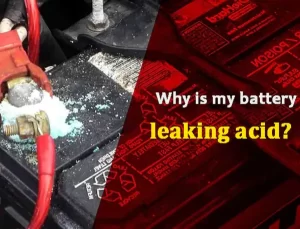Battery acid, or sulfuric acid, is a highly corrosive substance commonly found in lead-acid batteries, such as those used in cars, motorcycles, and other vehicles. This article aims to shed light on the distinct smell associated with battery acid and provide guidance on its safe disposal.
Part 1. What is battery acid?
Battery acid, or sulfuric acid, is highly corrosive in lead-acid batteries. Commonly, people use these batteries to power vehicles like cars, trucks, motorcycles, and boats. Battery acid plays a crucial role in the functioning of these batteries by facilitating the chemical reactions necessary for generating electrical energy. However, it’s essential to handle battery acid with extreme caution due to its potential to cause severe burns and damage to skin, eyes, and clothing upon contact.
Part 2. The role of battery acid in power generation
Sulfuric acid interacts with lead and lead dioxide plates within the battery to produce electricity when using a lead-acid battery. This process, an electrochemical reaction, powers the vehicle’s electrical systems, including starting the engine and providing electricity for lights and other accessories. While battery acid is typically diluted with water to form an electrolyte solution, it remains highly corrosive and can cause harm if mishandled. Taking proper precautions when handling lead-acid batteries is essential to minimize the risk of accidents and injuries related to battery acid exposure.
Part 3. Why do batteries leak acid?

Overcharging
One common reason for battery acid leakage is overcharging. Excess heat is generated within the battery when charged beyond its capacity or for an extended period. This can cause the battery to become overpressurized, leading to cracks or ruptures in the casing. As a result, battery acid may leak out through these openings.
Physical Damage
Physical damage to the battery casing is another factor that can cause acid leakage. Dropping or mishandling batteries can cause cracks or punctures in the casing, allowing acid to escape. Additionally, corrosion or rusting of the casing due to exposure to moisture or other corrosive substances can weaken the casing, making it more susceptible to leakage.
Age and Wear
As batteries age, their internal components degrade, increasing the likelihood of acid leakage. Over time, the seals and connections within the battery may deteriorate, allowing acid to seep out. Moreover, repeated charging and discharging cycles can cause wear and tear on the battery, compromising its integrity and increasing the risk of leakage.
Manufacturing Defects
In some cases, battery acid leakage may occur due to manufacturing defects. Flaws in the design or assembly of the battery can create weak points in the casing, making it prone to leakage under normal operating conditions. Quality control measures during the manufacturing process are essential for minimizing the risk of defects and ensuring the integrity of the battery casing.
Part 4. Identifying the smell of battery acid
Description of the Odor
The smell of battery acid is unique and easily distinguishable. It often carries a strong, sour odor reminiscent of rotten eggs or a sharp, chemical scent. This distinct smell results from sulfuric acid in the battery, which emits sulfur dioxide gas upon exposure to air. It’s important to note that while the odor may vary in intensity, it generally stands out due to its intense nature. Comparatively, unlike pleasant scents like flowers or freshly baked bread, the smell of battery acid is harsh and unpleasant. By recognizing this distinctive odor, individuals can quickly identify potential issues with battery acid leakage and take appropriate action.
Recognizing Signs of Battery Acid Leakage
Identifying battery acid leaks is crucial for maintaining safety and preventing damage. One of the key indicators is the smell of battery acid, which often accompanies leaks. It could signify a leak if you detect a strong, sulfuric odor like rotten eggs near a battery or electrical equipment. Additionally, visual cues such as corrosion or discoloration around the battery terminals or nearby surfaces may indicate leakage. Corrosion appears as a white or greenish powdery substance on metal surfaces. At the same time, discoloration can manifest as darkened or discolored areas. Individuals can promptly address battery acid leaks by paying attention to these signs, minimizing the risk of harm and potential property damage.
Part 5. What to do when batteries leak?
By following these steps, individuals can safely dispose of battery acid while minimizing the risk of harm to themselves and the environment.
How do you neutralize battery acid?
Before disposal, diluting battery acid with water is crucial to reduce its acidity. For safety purposes, always wear protective gear such as gloves and goggles. Carefully pour the battery acid into a large container filled with water, ensuring a dilution ratio of at least ten parts water to 1 part acid. Stir the mixture gently to ensure thorough dilution.
Neutralizing the Solution
After dilution, it’s essential to neutralize the solution to make it safer for disposal. You can slowly add baking soda or another neutralizing agent to the mixture while continuously stirring. Continue adding the neutralizing agent until it neutralizes the acid, indicated by the solution no longer fizzing.
Safe Disposal
Once neutralized, the solution can be safely disposed of by local regulations. Transfer the neutralized mixture to a designated hazardous waste disposal container or contact your local waste management facility for proper disposal. Never pour battery acid or its neutralized solution down drains, sewers, or onto the ground, as it can contaminate water sources and harm the environment.
How to clean a leaky battery?
After disposal, thoroughly clean and decontaminate any equipment or surfaces that came into contact with the battery acid. Use a solution of water and baking soda to clean affected areas, then rinse with water and dry thoroughly. Dispose of any contaminated materials, such as gloves or rags, by local regulations.
Part 6. Conclusion
Battery acid emits a distinct smell that people often describe as spicy and sour, resembling the scent of rotten eggs. This odor is a warning sign of potential battery damage, leakage, or the release of harmful gases. Suppose you detect the smell of battery acid. Handling the situation carefully and following proper safety protocols is crucial.
Part 7. FAQs
-
What color is battery acid?
Battery acid is typically colorless or slightly yellowish in appearance. -
Is the rotten egg smell from a battery dangerous?
Yes, the rotten egg smell from a battery can be dangerous. It indicates potential battery damage, leakage, or the release of harmful gases, which can pose health risks if inhaled or exposed for prolonged periods. -
Is battery corrosion toxic?
Battery corrosion can contain toxic substances, such as lead or sulfuric acid. Please avoid direct contact with battery corrosion, which can cause skin irritation and potential health hazards. Handling battery corrosion carefully and using protective gear when cleaning it is essential. -
Is battery acid dangerous?
Yes, battery acid is dangerous. It is highly corrosive and can cause severe burns and damage to the skin, eyes, and respiratory system if directly exposed. Proper precautions, such as wearing protective gear, are essential when handling battery acid. -
What happens if you touch battery acid?
If you touch battery acid, it can cause skin burns, irritation, and corrosion. It is essential to wash the affected area with plenty of water immediately and seek medical attention if necessary. Avoid touching your face or other sensitive areas before thoroughly washing your hands to prevent further harm.
Related Tags:
More Articles

Overview of Deep Cycle Lithium Battery
In this article, we explore the life, voltage, capacity, and charging considerations of deep cycle lithium batteries.
How Long do Lithium Batteries Last?
How long do lithium batteries last? we will explore the factors that influence the lifespan of lithium batteries and provide insights into their longevity.
How to Choose the Best LiFePO4 Battery?
Choose LiFePO4 batteries for superior performance, safety, and versatility in EVs, UPS, and backup power. This guide helps you make informed decisions.
Get 12v Lithium Car Battery As a Power Source for the Ride
Make the right choice for your vehicle's battery needs by installing a 12 volt lithium car battery. You will enjoy maintenance-free longevity with this change.
Everything About A Small Lithium Ion Battery
Discover the features, uses & future potential of a small lithium ion battery. A compact and tiny powerhouse ideal for smartphones, wearables, drones & more.





